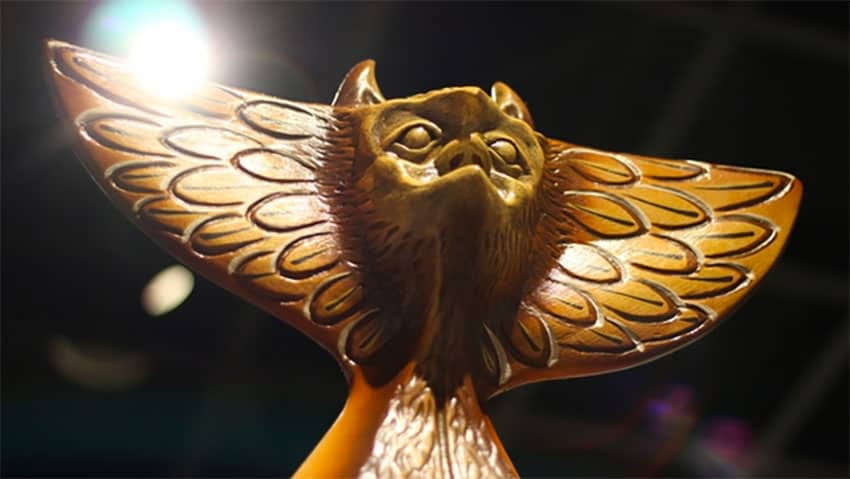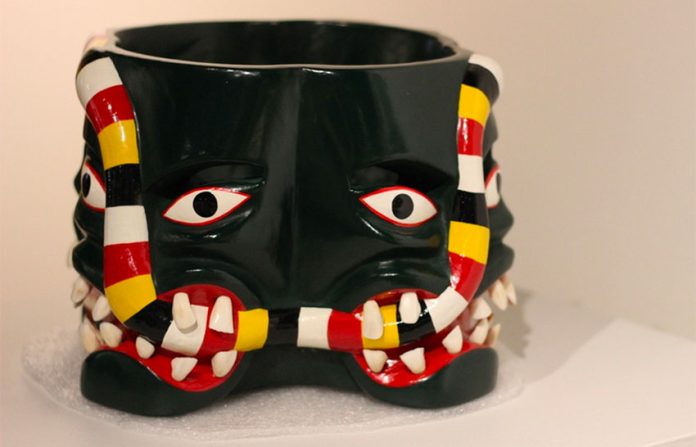Twelve years ago, the Museo de Arte Popular (Folk Art Museum) in Mexico City decided to establish an event to pair artisans with fine artists, designers, architects and the like to create and exhibit innovative works.
The idea was to erase the dividing line or barrier between fine and folk art as well as to encourage exchanges of ideas among the various fields.
And so the Bienal Arte/Sano ÷ Artistas was born.
The name is a play on words: arte (art) and sano (healthy) together spell artesano (artisan) and are followed by the division sign, which is read as divided by or among.
According to museum director Walther Boelsterly “. . . the barrier between the worlds of handcrafts and fine art is artificial. Both artist and artisan are creators. I think that the distance that has been created is because the market has decided that one is more important than the other.”

Over the years, the biennial, as it is known, has exhibited works such as vases, large jars, lamps, textiles, jewelry and furniture, along with more “typically artistic” pieces such as sculptures, murals and installations. All entries are based on materials that are traditional in Mexican handcrafts such as ceramics, blown glass, wood, leather, metals and more.
This year’s edition, the sixth, is dedicated to Oaxacan painter Francisco Toledo, who died this year. He was a noted promoter of the state’s handcrafts and participated in the first Arte/Sano event. The opening of the biennial also paid homage to the 100th anniversary of Germany’s Bauhaus movement, which combined fine art, handcrafts and technology.
Invited artisans include traditional clothing weaver Remigio Mestas Revilla of Yalalag, Oaxaca, copper and silver smith Abdon Punzo of Santa Clara del Cobre, Michoacan, and paper maché (cartonería) artisan Oscar Becerra of Mexico City. Invited artists and others include sculptor Angela Gurria, mathematician and sculptor Alba Rojo and sculptor Yvonne Domengue.
One of the pairings at the exhibition is that of mixed media artist Mary Stuart and Teotitlán del Valle (Oaxaca) weaver Enrique Jerónimo Hernández Ruiz to create a work called El Vacío.
The work consists of two woven pieces, one black and one white, both highly stylized arrows. The arrows are based on those found on Muslim prayer rugs, which are supposed to point toward Mecca at the indicated times. The design idea is based on Stuart’s experience in the Muslim world, as well as Hernández’s knowledge of how to weave (and unweave) his work to create unusual rug shapes.
Stuart has nothing but praise for Hernández’s professionalism and technique.
“My experiences with working with Mexican artesanos such as maestro Enrique Jeronimo have been absolutely positive. I have had the pleasure of working with this artisan for over 18 years. I knew nothing about weaving when I began and still do not know that much. However, we have no problems communicating. He has always understood my ideas and works with me to make them possible. Nothing has ever been ‘lost in translation’ in the collaboration.”
Mexico does have a history of contact and collaboration among artisans and artists. Artists such as Dr. Atl and Roberto Montenegro worked to promote traditional handcrafts after the Mexican Revolution, writing the first modern treatises on the subject.
Artisans have taken cues from fine art and other creative endeavors. The most famous examples of this is the image of La Catrina (attributed to graphic artist José Guadalupe Posada) and that of Frida Kahlo, which can be found in just about every medium available.
The exhibition runs until February 23.
Source: Milenio (sp)
